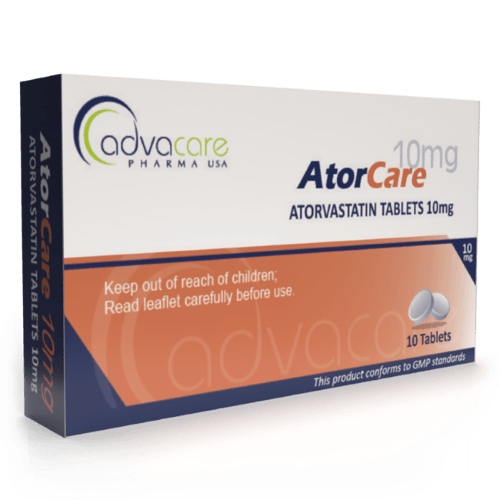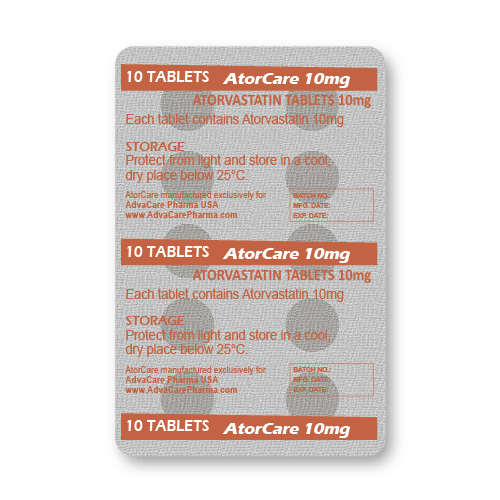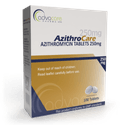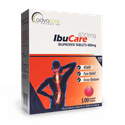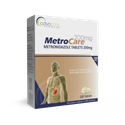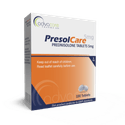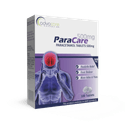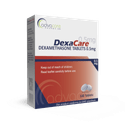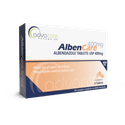- Home›
- Pharmaceuticals›
- Pharmaceutical Tablets›
- Atorvastatin Tablets
Atorvastatin Tablets
Dosage
Packaging
What is Atorvastatin?
Active Ingredients: Atorvastatin
Atorvastatin Tablets are a drug used to treat high cholesterol and lower the risk of stroke, heart attack, coronary heart disease, and other heart complications in patients with risk factors. It is typically used in combination with a low-fat/low-cholesterol diet and other lifestyle changes.
Atorvastatin Tablets are also indicated for the treatment of familial heterozygous hypercholesterolemia in children and teenagers.
Atorvastatin belongs to the class of drugs known as HMG-CoA reductase inhibitors (statins). It works by blocking enzymes that produce molecules needed to produce cholesterol, low-density lipoprotein (LDL), and very-low-density lipoprotein (VLDL). The resultant reduction in cholesterol and lipid levels reduces the risk of cardiovascular disease.
AdvaCare Pharma is a trusted global exporter of Atorvastatin Tablets. This medication is produced in our GMP-certified facilities in China, India, and the USA. Our manufacturing facilities are regularly inspected to ensure they comply with WHO's standards, rules, and regulations.
Why are we a leading Atorvastatin manufacturer?
As a reputable Atorvastatin manufacturer, we are dedicated to ensuring that GMP guidelines and standards strictly apply to the manufacture of our entire range of 200+ pharmaceutical treatments in tablet dosage form.
AdvaCare Pharma is an American pharmaceutical company committed to the manufacture of high-quality, affordable pharmaceuticals for a global market. The extensive international network that we partner with includes pharmaceutical distributors, hospitals, pharmacies, and a variety of other medical institutions. Our vision is to manufacture Atorvastatin Tablets, and other quality-assured oral solid treatments, that get into the hands of those that need them most.
Uses
What is Atorvastatin used for?
It is used to treat high cholesterol and to reduce the risk of heart attack and stroke in those with or who have a predisposition for heart disease.
How are Atorvastatin Tablets used?
This medication is intended to be taken orally. Atorvastatin Tablets may be taken with or without food.
What dose should be taken and for how long?
Recommended dosage may vary based on different medical conditions:
- For the treatment of hyperlipidemia and mixed dyslipidemia, the recommended initial dose of atorvastatin is 10 or 20mg once daily. Patients requiring a larger reduction in LDL-C (> 45%) may start at 40mg once daily. Within 2 to 4 weeks of treatment initiation and dosage titration, lipid levels should be monitored and the dosage adjusted accordingly.
- For the treatment of heterozygous familial hypercholesterolemia in children (≥ 10 years), the recommended starting dose of atorvastatin is 10mg once daily. Dosage adjustments should be made every 4 weeks or more based on the treatment goal.
- For the treatment of homozygous familial hypercholesterolemia, the dose of atorvastatin can range between 10 and 80mg daily and should be used in combination with other lipid-lowering treatments.
The exact dosage is dependent on age and body weight. Refer to a doctor or pharmacist for guidelines on dosage. Do not exceed what they advise.
Who can use Atorvastatin?
Atorvastatin can be administered to adults and children (≥ 10 years), but caution is advised for specific groups of patients.
Pregnant Animal studies are inconclusive in determining atorvastatin’s potential to cause adverse fetal effects. Limited human data are insufficient to determine the risk of major congenital malformations or miscarriage associated with atorvastatin.
Atorvastatin may cause fetal harm, as it decreases the synthesis of cholesterol and other biologically active substances that are important for fetal development. Atorvastatin use during pregnancy is contraindicated and may not be medically necessary.
Nursing It is unknown if atorvastatin is excreted in human milk, but another drug in this class is excreted in human milk, and atorvastatin is excreted in rat milk. There is no information on the potential effects of atorvastatin in nursing infants, so nursing while taking atorvastatin is not recommended.
Pediatric In pediatric patients < 10 years old, the safety and efficacy of atorvastatin for the treatment of heterozygous familial hypercholesterolemia (HeFH) have not been established. In pediatric patients 10 to 17 years old, the safety and efficacy of atorvastatin use for the treatment of HeFH resembles those found in adult patients.
Geriatric Clinical studies have not revealed differences in the safety or efficacy of atorvastatin use in older adults (≥ 65 years) compared to younger adults (< 65 years). The increased sensitivity and risk of myopathy observed in older patients should be considered when administering atorvastatin.
When and why is the best time of the day for Atorvastatin Tablets dosage?
Atorvastatin is often recommended to be taken in the evening or at bedtime. This timing is based on the body's natural circadian rhythm and the fact that cholesterol production increases during the night. Taking Atorvastatin in the evening helps maximize its effectiveness in reducing cholesterol levels, particularly low-density lipoprotein (LDL) cholesterol.
Other warnings
In patients with renal insufficiency, dosage adjustments are not necessary, as renal function does not influence atorvastatin plasma concentrations.
In patients with acute liver disease or unexplained persistent transaminase elevations, atorvastatin use is contraindicated. Caution should be exercised when prescribing atorvastatin to patients with alcohol use disorder and/or a history of liver disease. Rare reports of hepatic failure, fatal and non-fatal, have been associated with statin use. Liver enzyme tests should be performed before and during atorvastatin treatment. If signs or symptoms of liver injury, hyperbilirubinemia, or jaundice occur, treatment should be discontinued immediately. Symptoms that may indicate liver injury include fatigue, loss of appetite, right upper abdominal pain, dark urine, or jaundice.
Atorvastatin may cause myopathy and rhabdomyolysis. Rare fatalities have occurred from statin-related rhabdomyolysis. Patients at an increased risk for developing myopathy are aged 65 years or more, have uncontrolled hypothyroidism, renal impairment, concomitantly using certain drugs, and receiving higher atorvastatin doses. Myopathy may manifest as unexplained muscle pain, tenderness, or weakness, particularly if accompanied by malaise or fever. The concomitant use of certain anti-viral, azole antifungals, or macrolide antibiotic medications and the consumption of quantities of grapefruit juice exceeding 1 liter a day may increase the risk of these effects. If elevated CK levels occur or myopathy is proven or suspected, atorvastatin should be discontinued immediately. Muscle symptoms and CK increases may resolve with atorvastatin discontinuation.
Atorvastatin treatment should be discontinued in patients at an increased risk for the development of renal failure secondary to rhabdomyolysis, such as those with severe acute infections, hypotension, recent major surgery or trauma, severe metabolic, endocrine, and electrolyte disorders, and uncontrolled seizures.
Rare reports of immune-mediated necrotizing myopathy (IMNM), an autoimmune myopathy, have been associated with statin use. Clinical signs and symptoms of IMNM include proximal muscle weakness and elevated serum creatine kinase, positive anti-HMG CoA reductase antibody, and muscle biopsy showing necrotizing myopathy. IMNM may improve with immunosuppressive agent treatment.
Increases in HbA1c and fasting serum glucose levels have been reported with HMG-CoA reductase inhibitors, including atorvastatin. These effects should be considered when administering atorvastatin to patients with diabetes.
Atorvastatin may theoretically reduce adrenal and/or gonadal steroid production. Atorvastatin has not been found to reduce basal plasma cortisol concentrations or impair adrenal reserve. The effects of statins on male fertility have not been adequately studied. The effects on female fertility are unknown. Concomitant administration of atorvastatin with drugs that may decrease the levels or activity of endogenous steroid hormones, such as ketoconazole, spironolactone, and cimetidine, should be done with caution.
In a study of patients who had a stroke or transient ischemic attack (TIA) within the preceding 6 months, an increased incidence of nonfatal hemorrhagic stroke was seen in those receiving atorvastatin compared to controls. The incidence of fatal hemorrhagic stroke was similar in both treatment groups. Baseline characteristics, including a history of hemorrhagic and lacunar stroke upon study entry, were associated with a higher incidence of hemorrhagic stroke in the atorvastatin treatment group.
Central nervous system (CNS) toxicity, including brain hemorrhage, optic nerve vacuolation, and tonic convulsions, has been observed in animal studies of atorvastatin administration. CNS vascular lesions, characterized by perivascular hemorrhages, edema, and mononuclear cell infiltration of perivascular spaces, and optic nerve degeneration have been observed in animals treated with other medications in this class.
Concomitant use of cyclosporine or certain protease inhibitors may require reductions in atorvastatin dosages. Caution should be exercised, as some may be contraindicated.
Atorvastatin has not been studied in conditions where the major lipoprotein abnormality elevated chylomicrons (Fredrickson Types I and V).
Side Effects
As with all pharmaceuticals, some unwanted effects can occur from the use of Atorvastatin Tablets.
Common side effects include, but may not be limited to:
- diarrhea
- heartburn
- gas
- joint pain
- confusion or forgetfulness
Seek medical attention if these develop:
- muscle problems
- lack of energy or extreme tiredness
- signs of liver problems (fatigue, loss of appetite, dark urine, yellowing eyes/skin)
- flu-like symptoms
- signs of an allergic reaction
For a comprehensive understanding of all potential side effects, consult a medical professional.
If any symptoms persist or worsen, or you notice any other symptoms, please call your doctor immediately.
Precautions
Do NOT use Atorvastatin Tablets if:
- You are allergic to atorvastatin or any of the ingredients.
- You have a history of kidney disease.
- You have acute liver disease or unexplained elevated hepatic transaminase levels.
- You have alcohol use disorder.
- You are pregnant or breastfeeding.
- You are taking cyclosporine, gemfibrozil, tipranavir/ritonavir, or glecaprevir/pibrentasvir.
Before treatment, consult your doctor regarding any medications you are taking to address potential drug interactions.
This medication may not be suitable for people with certain conditions, so it is important to consult with a doctor if you have any health conditions.
References
Cholesterol Reduction With Atorvastatin Improves Walking DIstance in Patients With Peripheral Arterial Disease
The main goal of this study was to determine whether cholesterol-lowering with atorvastatin improves walking performance in patients with intermittent claudication.
This is a randomized, double-blind, parallel-design study that included 354 persons with claudication attributable to peripheral arterial disease. The participants in the study were treated with placebo, atorvastatin (10mg per day), or atorvastatin (80mg per day) for 12 months. Changes in treadmill exercise time, patient-reported measures of physical activity, and quality of life based on questionnaires were measured during the study. There was improvement in pain-free walking time after 12 months of treatment for the 80mg (P=0.025) group compared with placebo. The results from the physical activity questionnaire demonstrated improvement in ambulatory ability for the 10- and 80-mg groups (P=0.011).
The findings indicate that atorvastatin improves pain-free walking distance and community-based physical activity in patients with intermittent claudication. These patients can experience improvement in symptoms to complement the anticipated reduction in cardiovascular events.

You might be interested in...
Why AdvaCare Pharma?
As an industry leader, we are aware of our responsibility to provide affordable and sustainable solutions to improve healthcare worldwide.
